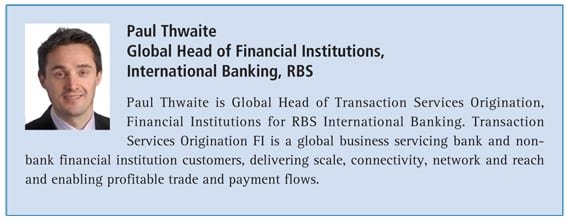by Paul Thwaite, Global Head of Financial Institutions, International Banking, RBS
The ability to provide efficient transactional FX services – such as international cross-currency payments – in a variety of changing markets can be a challenge. Reducing costs, increasing efficiency and providing products and services that are highly attractive to prospective clients are all options that can be explored by financial institutions in the quest to retain market share or expand their operations.
For many financial institutions though, adding greater simplicity, automation, control or flexibility can help to provide significant and welcome operational benefits. In an environment of regulatory alignment and integration across global markets, there continues to be robust demand for services that can generate such gains and are easy to implement.
Assessing the market
Any thorough assessment of a business against its competitors will take into account the prospects of the market as a whole and the ability of the company to capitalise on opportunities within that market. As a result, it’s essential to understand the factors which may support such expansion and those which might restrict it. A central theme that is affecting the day-to-day considerations of financial institutions across many of the markets is a need for better transparency and clarity. Authorities in many countries are increasingly accepting of the positive effects that inculcating a more rigid legal and regulatory framework can have on the market as a whole.
This theme has been driven for some time by consumer legislation that in turn is shaping the products and services offered by banks and financial institutions. Action by governments to apply similar transparency requirements to business-to-business relationships means that many financial services sectors are becoming more aligned.
Sign up for free to read the full article
Register Login with LinkedInAlready have an account?
Login
Download our Free Treasury App for mobile and tablet to read articles – no log in required.
Download Version Download Version


























